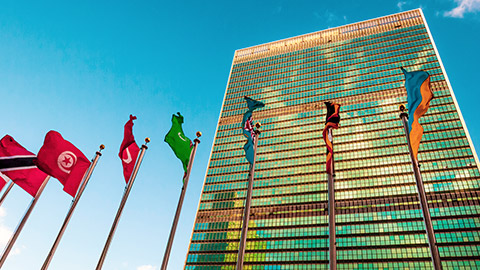Welcome to Multinational Enterprises. In this topic you will learn about:
- Multinational corporations (MNCs)
- Foreign direct investment by multinational corporations
- Differences between licensing and franchising
- Importing and exporting
- Types of codes used to guide corporate behaviour
In this topic, we will assume that an Australian business wishes to operate in one or more countries other than Australia. We call this type of business a multinational enterprise. We will also consider how such an enterprise does business internationally. There are a number of options. Exporting or importing goods and or services being one. When a business is involved in exporting or importing goods, services they need to consider costs and any impediments posed by the law of Australia, or in the country, they wish to trade with.
Another option available to businesses is to licence their intellectual property or establish a franchise. We will explain these two methods and examines the advantages and disadvantages of each. Establishing a distributorship or branch office in another country is also an option. Sometimes a company will establish a subsidiary company, either fully owned or partly owned by a parent company, to operate business internationally and the below essential resources consider how such an arrangement could be established.
An issue that will arise for multinational enterprises is ‘what’ law governs their operations? Is it municipal (local) law or the law of the country they are trading with? One global standard that lays down the responsibility of multinational enterprises is the Organisation for Economic Co-operation and Development (OECD) Guidelines for Multinational Enterprises. This document provides a framework for conduct however, this is a no- binding set of rules that countries may choose to adopt.

Multinational corporations defined
A multinational corporation (MNC) is defined as an entity headquartered in one country that does business in one or more foreign countries. Many multinational corporations or MNCs progress through the following stages:
- Exporting products to foreign countries
- Establishing sales organisations abroad
- Licensing use of patents and technology to foreign firms that make and sell the MNCs products
- Establishing foreign manufacturing facilities, but control remains at the home office.
Case study: The Coca-Cola Company
The Coca-Cola Company was formed by Asa Candler 1882. Today, the Coca-Cola Company is the world’s largest manufacturer, distributor, and marketer of soft-drink concentrates and syrups. Over the years, the company has transformed itself from a single-product firm into a producer and marketer of a beverage portfolio which encompasses 400 brands and 2,600 beverage products. Although the company has millions of satisfied customers in foreign lands, it is sometimes confronted with violent critics who resent American influence. The Coca-Cola story illustrates the development, strategy, and unique problems of a large multinational corporation.
The United Nations calculates there are 77,000 transnational corporations or TNCs in the world and they have 770,000 affiliates. Most of the parent firms of the largest TNCs, are based in the developed economies of the United States, Europe, and Japan. The top 100 transnational firms operate (on average) in 40 countries.
The following video explains the features of multinational corporations. As you watch take note of the four different types of multinational enterprises and the advantages of establishing such an entity.
How transnational is a corporation?
Corporations vary in range of international dimensions; these variations include a ratio of domestic to foreign operations, the number of foreign countries entered and so on. There is no single measure that can capture the definitive meaning of ‘multinational’. The transnationality index is but one measure used by the United Nations to rank corporations, and is deduced based on the relative importance of their domestic and foreign operations. However, the economic and political clout of transnational corporations (TNCs) is not defined solely by numbers on any dimension.
We will briefly explore licensing, franchising and the differences between exporting and importing as these are popular options for Australian businesses operating in countries outside Australia.
Licensing vs franchising
A business may consider possible options for trading internationally and sometimes licensing and franchising may be considered appropriate. The following short video explains the difference between franchising and licensing as a way of entering markets in other countries. The video also refers to the code of conduct that must be adhered to when franchising and licensing. Licensing and franchising will be included in your topic forum.
The following resources provide more information on licensing and franchising.
Explore the content on the Entering a foreign market through licensing website. This webpage explains how a business can enter foreign markets by licensing their intellectual property. Take particular note of the definition of licensing and the key benefits of this business approach.
Explore the Legalvision website for information on how to license your Australian brand overseas. This webpage deals with Australian businesses wishing to expand their operations internationally and provides details of the contents of a licensing agreement and the benefits of such an agreement.
Importing and exporting
We will now look at importing and exporting. As you establish a business, it is important to consider whether the product or service will need to come from another country or you wish to export your goods and services overseas.
- Importing: Importing involves bringing products or services into a country from overseas. For example, buying an item from the United States and importing it to Australia.
- Exporting: Exporting involves sending the goods from one country to another. For example, Australia exporting a product such as Vegemite to the United States.
Spend some time on the importing and exporting website to familiarise yourself with importing and exporting for Australian businesses. It is important you review the information on this website as there may be content pertaining to the country you are focussing on for your assessment. You will find a link that will take you to the Australian Customs requirements for imports. There is also specific information for doing business in Asia (see the 11 Country Starter Packs).
While you are on the website, take the time to:
- look at the resources provided for exporting including the International Readiness Indicator
- explore the information on Efic’s Small Business Loan for exporters to finance an export initiative.
This resource is required to help you with your topic forum activity on importing and exporting.
Foreign direct investment (FDIs) are funds invested by an MNC and one nation for starting, acquiring, or expanding an enterprise in another nation. The annual fees of FDI have increased dramatically, rising from $202 billion in 1990 to $916 billion in 2005!
There are three reasons corporations make foreign direct investments:
- In order to seek access to new markets
- To grow beyond a small domestic market
- To achieve cost and other competitive advantages over competitors.
Foreign direct investments in less developed countries
A less developed country (LDC) is defined by the United Nations (2020) ‘as a country or countries that are low-income countries confronting severe structural impediments to sustainable development. They are highly vulnerable to economic and environmental shocks and have low levels of human assets.’
Multinational corporations are for-profit entities that seek an adequate return on the capital invested in less developed countries and the investments can be significant within local economies. Many LDCs have altered their trade and investment policies to become more attractive to MNCs. Other elements in the international community have moved from a hostile attitude toward MNCs to embrace a new pragmatism about the promise of FDI. The US Alien Tort Claims Act ( a US Law) has been used to bring civil actions in the US courts against corporations for violating international law anywhere in the world.
Negative effects of foreign direct investments
It is recommended you spend time on the Pros and Cons of Setting up a Foreign Subsidiary webpage as it explores the pros and cons of setting up a branch office or foreign subsidiary. The reasons for establishing a branch office or subsidiary are considered in conjunction with the steps involved in closing down a foreign branch or subsidiary. This resource also explores the alternative of utilising a local employer of record as an alternative.
When a MNC enters an FDI arrangement with a less developed country or countries, there is a risk of some negative effects that may impact the MNC. For example, competition from a new foreign affiliate can overwhelm local firms and come to monopolise the domestic market. MNCs have been criticised for repatriating profits back to home countries, so that local residents get limited benefit from the MNCs’ presence. The economic impact of multinational corporations is often accompanied by social impacts, which can be negative, for example, there have been lawsuits against corporations that alleged human rights abuses, labour abuses, and environmental crimes.

International codes of conduct are aspirational statements of principles, policies, and rules for foreign operations that multinational corporations voluntarily agree to follow. For example, the Sullivan Principles required multinational corporations and South America to do business in a non-discriminatory way. In the 1990s, code making exploded as a response to the expanding activities of MNCs.
Codes of conduct include:
- corporate codes
- industry codes
- and many other international social responsibility codes.
Let us look at these in more detail below.
Corporate codes
Corporate codes are usually adopted in response to activist attacks, critical review reports, or general concern for maintaining an MNC’s legitimacy. The content of a corporate code promises behaviour that overcomes the charges of critics and so they vary in focus. Some codes contain a 'snowball clause', which is the requirement that contractors use their power over firms in their own supply chains. Most companies reject rigorous monitoring by outsiders and simply check on themselves.
Industry codes
When an industry is besieged by critics, it sometimes creates an industry-wide code as a result. An unspoken advantage is an industry-backed organization that executes the code will be lenient with member companies. Industry codes are attacked as loose and relaxed compared with traditional government regulations.
Other codes
There are several other codes that are used internationally, including the:
- Caux Round Table Principles for Business
- Code of Ethics on International Business for Christians, Muslims, and Jews
- Business Charter for Sustainable Development
- OECD Guidelines for Multinational Enterprises
- Free Labor Association Workplace Code of Conduct.

The United Nations Global Compact is a set of ten principals based on rights and norms in international agreements. The principles cover four areas:
- Human rights
- Labour standards
- Environment
- Anticorruption.
The principles serve two central purposes. Firstly, to promote corporate responsibility and MNCs and secondly, to form cooperative networks of its participants for solving the problems of economic globalisation.
End of topic forum
There are forum activities for this topic. The forum activity for Topic 6 requires you to consider the nature of the business you are operating in to prepare for Assessments 2 and 3. Your task is to consider if licensing or franchising is a possible way of doing business internationally. Select the ‘Forum’ at the end of your module (which can be found within your navigation menu) and follow the instructions for each question pertaining to Topic 6 within the forum.
What is a distribution agreement?
Read the material on this page that defines a distribution agreement. There are links to distribution templates. Note, the key issues parties to such an agreement must consider and the clauses that should be included in all distribution agreements.

